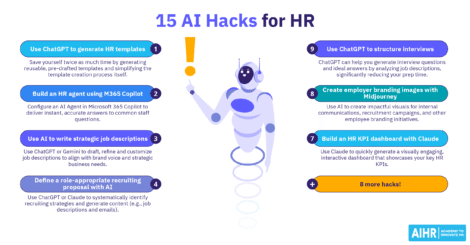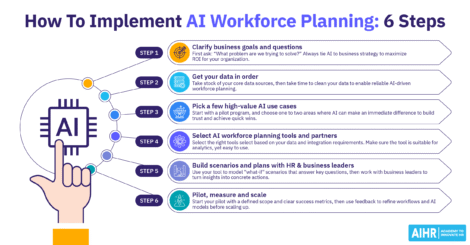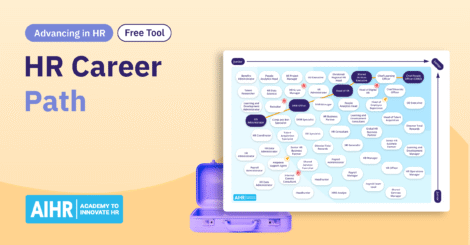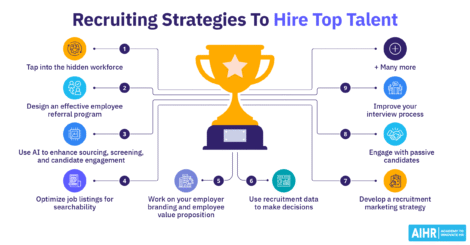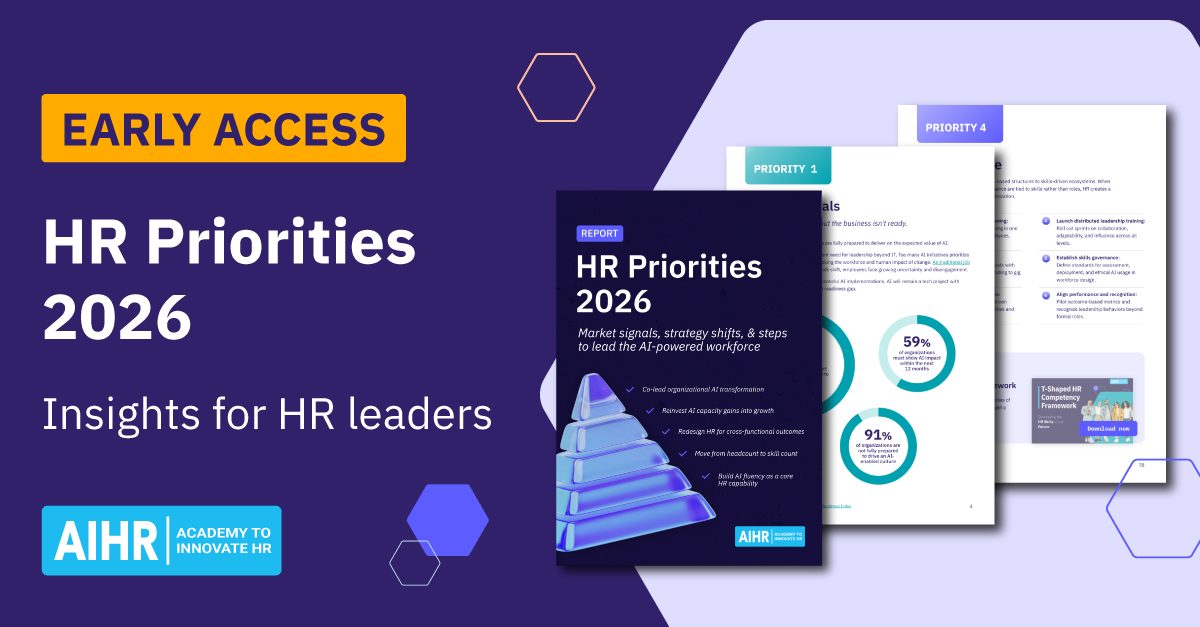The promise of AI in Human Resources is significant: enhanced effectiveness, data-driven insights, and time-saving automation of mundane tasks, freeing up HR professionals to focus on more strategic activities. And these aren’t just claims – they’re backed by research, as evidenced by this survey in which 65% of HR professionals reported that AI has positively impacted the productivity and efficiency of their departments.
But while the gains are real, the challenges of AI in HR are just as important to acknowledge.
Successful integration goes beyond simply adopting an AI tool. HR leaders need to proactively understand and overcome obstacles to capitalize on AI’s transformative potential. Use this article as your guide.
Contents
What are the main challenges of AI in HR?
7 actions for HR leaders to address AI in HR challenges
FAQ
What are the main challenges of AI in HR?
While AI promises a future of optimized workflows and predictive insights, there are several serious obstacles to overcome.
Short-term focus vs. long-term strategy
Successfully integrating AI into HR often faces challenges due to the need to balance immediate operational demands with long-term strategic objectives. HR teams, eager to achieve quick wins, may implement tactical tools without considering how they will align with future goals. For example, deploying an AI chatbot for immediate query resolution can lead to isolated pockets of efficiency and limited overall value if not properly integrated.
Conversely, AI’s unprecedented rate of change makes it exceptionally difficult to design a long-term strategy given the limitations in understanding how and when AI capabilities may evolve in the near- and mid-term. This challenge contributes to fragmented systems and diminishes the compounding benefits of AI.
Without a clear strategic roadmap, organizations treat AI investments as isolated exercises rather than as integrated components of a cohesive HR ecosystem – an approach that leads to inefficient workflows and siloed data.
AI tool overload and decision fatigue
The explosion in AI solutions hitting the market presents another significant challenge. For HR leaders, the sheer volume of new tools and the rapid pace of change can be overwhelming.
Evaluating which tools genuinely solve specific problems, are worth substantial investment, and deliver measurable value can be a daunting task. Without clear criteria and an evaluation framework, organizations risk investing in tools that don’t integrate well, or they may simply default to the perceived ‘safest’ option over the most effective. This can lead to costly mistakes.
Another hard truth is that the rapid pace of AI innovation means organizations face being leapfrogged by new, superior AI capabilities. Investments made today can quickly become obsolete.
Bias in algorithms
One of the most critical and ethically charged challenges of AI in HR is the risk of bias in algorithms. AI tools learn from historical data, and if that data reflects existing human biases – whether conscious or unconscious – the AI may not only replicate those biases but also amplify them. Left unchecked, this can result in widespread unfair or discriminatory outcomes in essential HR decisions, such as candidate screening, performance evaluations, and promotion pathways.
For instance, an AI trained on historical hiring data that disproportionately favours unnecessary skills or qualifications for certain roles might inadvertently filter out qualified applicants, perpetuating existing imbalances. The consequences are severe: legal risks, reputational damage, and a significant erosion of trust among employees and candidates. Addressing bias requires meticulous data auditing, diverse training datasets, and continuous monitoring.
Lack of transparency
Many advanced AI systems, particularly complex machine learning models, operate like ‘black boxes.’ They generate accurate predictions, but their underlying logic is often unclear. For HR teams, this lack of transparency poses a major challenge.
When candidates or employees question an outcome, it may be difficult to understand or justify AI-driven decisions. For instance, if HR cannot explain why a resume was rejected or why an AI-powered performance rating was given, it can lead to frustration and accusations of unfairness.
This opacity fosters distrust, making it nearly impossible to audit or rectify errors effectively. Without transparency, HR leaders struggle to fully trust AI outputs or confidently defend their decisions.

Integration with existing systems
Today’s HR departments rely on a complex tech stack, including various HR information systems (HRIS), applicant tracking systems, payroll systems, and learning management systems.
A major challenge you’ll likely face when implementing AI in HR is ensuring seamless integration with these existing platforms and workflows. For instance, an AI-driven onboarding platform may struggle to pull employee data from an outdated HRIS, leading to manual data entry and undermining its intended efficiency. This situation can create inefficiencies and data silos, necessitating costly custom development to enable system communication.
The effort and cost associated with integrating new AI solutions can pose a significant barrier to adoption, resulting in ongoing operational headaches. Integration issues often lead to manual data transfers, inconsistent data sets, and a failure to achieve the end-to-end automation or insights generation that AI promises.
Skill gaps and resistance to change
Many HR teams lack the data literacy needed to interpret AI-generated insights, the technical understanding to troubleshoot issues, and the strategic foresight to identify appropriate AI use cases. These critical skill gaps are serious on their own, but the challenge is compounded by resistance to change and apprehension over AI.
With reports predicting that AI will disrupt nearly half of workers’ core skills within five years, the fear of job displacement due to AI’s ability to automate human tasks is well-founded and can fuel resistance to AI adoption within the HR function itself. For instance, an HR Generalist accustomed to manual resume screening might feel threatened by an AI tool automating this process, leading to their reluctance to adopt the new technology.
To overcome these factors, HR leaders must invest in training and effective change management programs to cultivate a culture of continuous learning and adaptation within HR. Ultimately, this will help you to foster trust and competence in your department.
AI is transforming the world of work — but without the right knowledge, it can introduce more risks than rewards. Help your HR team confidently navigate the ethical, practical, and strategic challenges of AI.
With AIHR’s AI for HR Boot Camp, your team will:
✅ Understand the limitations and risks of AI in core HR processes
✅ Gain hands-on experience using generative AI in an HR context
✅ Build the awareness to balance innovation with ethics and compliance
🎯 Give your HR team the skills to turn AI challenges into strategic opportunities.
Lack of overall AI readiness
Beyond specific skill gaps, many organizations face a broader challenge: a fundamental lack of overall AI readiness. Successful AI adoption is not just about the technology; it requires a holistic approach that touches on these five key components:
- Culture: Is your organization open to experimentation, data-driven decision-making, and continuous learning?
- Governance: Do you have clear policies, ethical guidelines, and accountability frameworks in place for AI use?
- Resources: Have you allocated sufficient financial, technical, and human resources to AI initiatives?
- Capabilities: Does your organization possess the necessary technical and analytical expertise?
- Goals: Have you developed clear and measurable objectives for AI implementation that align with your business strategy?
Without a thorough assessment and development of these readiness components, your AI initiatives are likely to underperform.
If you want to explore the five key components of a successful AI strategy for HR – along with common pitfalls, how to avoid them, and practical steps to get started – take a look at AIHR’s AI Strategy Framework for HR Leaders.

Loss of human connection
At its core, HR is about people. While AI excels at automating tasks and processing data, over-reliance on automation can erode the essential empathetic human touch.
A human approach is indispensable in sensitive areas such as conflict resolution, career development, or employee wellbeing. Relying solely on an AI chatbot for grievance resolution rather than a human representative can fuel staff isolation and dissatisfaction.
The challenge for HR leaders is striking the right balance by leveraging AI for efficiency without sacrificing the genuine human connection that fosters trust, engagement, and supports the nuanced emotional aspects of the employee experience. An impersonal, AI-driven HR function risks alienating your employees and undermining HR’s core purpose.
Data, ethics, and legal and compliance risks
The deployment of AI in HR raises serious concerns about data privacy, ethical use, and compliance. Handling sensitive employee data with AI introduces new risks, including security breaches and the misuse of information, which can challenge adherence to global data protection laws, such as the GDPR and CCPA.
Furthermore, AI’s ethical boundaries are rapidly evolving, particularly in areas such as surveillance, algorithmic fairness, and the right to explanation. Keeping up with legislation is also a challenge; U.S. federal agencies introduced 59 AI-related regulations in 2024 alone, more than double the number introduced in 2023.
Companies must navigate the uncertain legal and ethical landscape of AI, ensuring accountability and mitigating liabilities. For instance, monitoring employee productivity without clear consent can lead to legal challenges and erode trust. Without strong data governance, clear ethical guidelines, and ongoing legal counsel, you may risk facing significant penalties and damaging your reputation.
7 actions for HR leaders to address AI in HR challenges
Navigating the complexities and challenges of AI in HR requires a proactive and strategic approach to unlock its benefits.
1. Start with a clear use case
Instead of chasing the latest AI trend, HR leaders should begin by identifying specific, well-defined business problems that AI can genuinely solve. This means moving beyond the hype and focusing on clear use cases where AI can deliver tangible value.
The process could include automating routine tasks in recruitment, improving personalized learning recommendations, or identifying employees at risk of burnout or churn. By starting small, demonstrating success, and then scaling, you can build momentum and internal buy-in.
This focused approach prevents fragmented systems and ensures your investments in AI are purpose-driven and aligned with your overall strategic objectives.
2. Systematically build HR’s AI readiness
Addressing the broader challenge of AI readiness needs a structured and multi-faceted approach. As an HR leader, you must actively assess your organization’s current state across a variety of elements of AI readiness: culture, governance, resources, capabilities, and goals.
Also, ensure your culture embraces innovation and data literacy and establishes clear ethical guidelines and accountability frameworks for AI. Next, allocate dedicated budgets and technical support, develop your internal expertise, and set measurable objectives for your AI initiatives.
Keep in mind, building readiness is an ongoing journey that requires continuous investment and adaptation.

3. Make AI fluency part of HR development
To bridge the critical skill gap, HR leaders must prioritize AI fluency as a core component of professional development for their teams.
This goes beyond basic training on how to use specific tools. It involves educating your HR team on the fundamental principles of AI, understanding how algorithms work (and importantly, where they can fail), interpreting AI-generated insights, and critically evaluating AI tech solutions.
Workshops, self-paced online AI for HR certificate programs, dedicated team boot camps, and cross-functional collaboration can empower your HR team to become informed users and strategic partners in the adoption of AI. This helps to establish confidence and reduce resistance to change.
4. Always keep humans in the loop
HR leaders must design AI systems that keep ‘humans in the loop’ to counteract the potential loss of human connection and maintain ethical oversight.
This means that your AI capabilities should augment, rather than replace, human judgment and empathy, particularly in sensitive or high-stakes decisions. For instance, AI can screen resumes, but human recruiters and hiring managers should always make the final hiring decisions.
AI can provide insights into employee sentiment, but skilled HR practitioners are essential for empathetic follow-ups and interventions. This hybrid approach leverages AI’s efficiency while preserving that critical human element that defines the very essence of effective HR.
5. Set guardrails for ethical, compliant use of AI
Given the significant data, ethical, and legal risks that unchecked AI can pose, as an HR leader, you must be proactive about establishing guardrails.
Start developing clear internal policies on data privacy, algorithmic fairness, and transparency. You also need to ensure compliance with relevant data protection regulations, such as the GDPR in the European Union or any federal or state law in the U.S., including the California Consumer Privacy Act (CCPA), and stay abreast of evolving AI legislation.
Establishing an AI ethics committee, conducting regular audits of your AI systems for bias, and partnering with legal counsel are a must. These guardrails protect your organization from legal liabilities and build trust with employees by showing your commitment to responsible AI use.
6. Encourage cross-functional collaboration
Successful AI implementation in HR for larger organizations is never an isolated effort. You’ll need strong collaboration across various departments, so actively partner with your IT, Legal, Data science, and business unit colleagues to ensure seamless integration, data security, ethical compliance, and alignment.
A collaborative approach helps break down silos and ensure that your chosen AI solutions are not only technically sound but also legally compliant and universally adopted across your organization.
7. Prioritize data quality and governance
AI is only as good as the data it’s trained on. That’s why it’s important to prioritize data quality and develop strong data governance frameworks. Successfully doing this requires ensuring that your HR data is accurate, complete, consistent, and free from bias.
Implementing clear data collection, storage, and access protocols is essential. Regular data audits, data cleansing projects, and the use of diverse and representative datasets are crucial for addressing algorithmic bias. This will lay the groundwork for reliable, fair AI-driven insights and decisions.
To sum up
The future of HR is undeniably linked to AI, but integrating AI into HR is no easy process. Navigating algorithmic bias, integration hurdles, fundamental skills gaps, and ethical concerns requires careful consideration and strategic foresight.
By focusing on clear use cases, building AI readiness, prioritizing AI fluency, and embedding ethical guardrails, HR leaders can harness AI responsibly and transform these challenges into opportunities.
FAQ
There are two categories of risks. The first focuses on system-level factors, including algorithmic bias that can lead to discriminatory outcomes, a lack of transparency that can make automated decisions difficult to explain, data privacy and security vulnerabilities, and integration complexities with existing systems. The second dimension of AI risks in HR is interpersonal by nature and involves the potential erosion of human connection and empathy in employee interactions.
Currently, AI is largely augmenting rather than replacing HR jobs. It automates repetitive, administrative tasks such as resume screening, scheduling interviews, and answering FAQ. This frees up HR professionals to focus on more strategic and human-centric activities such as talent development, employee relations, and organizational design.
However, some HR roles, particularly those heavily focused on routine tasks, are more susceptible to automation. HR leaders should take a proactive approach to upskilling their teams, focusing on data literacy, ethical AI use, and strategic capabilities, to ensure their function stays relevant and future-ready. AI is also creating new opportunities, from HR tech specialists to data ethicists, that forward-thinking teams can start preparing for now.
Key ethical issues include algorithmic fairness and bias, ensuring AI doesn’t discriminate, data privacy and security, which concern protecting sensitive employee information, and transparency and ‘explainability’ in understanding how AI makes decisions. Other factors include accountability for AI-driven outcomes and maintaining a balance that prioritizes employee-centricity while preserving human dignity and connection when automating HR processes.










